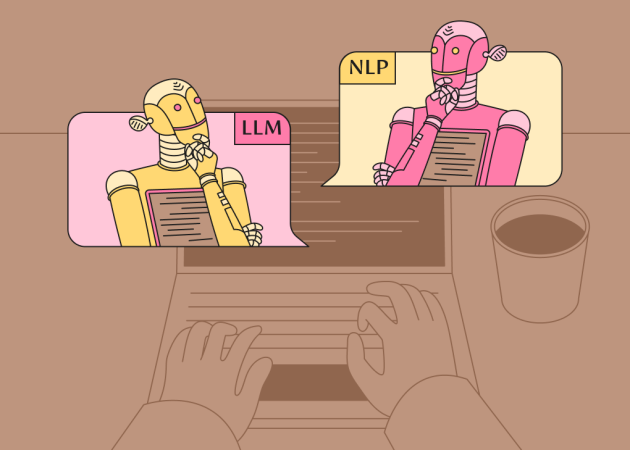
AI Development Cost: Can $5K Get You a Custom AI Solution in 2025?
Contents
Contents
There’s a persistent belief in the startup world that $5,000 is enough to build a fully functional AI product. And at first glance, it’s not a crazy idea — especially with so many tools like ChatGPT, Make, and Zapier promising fast results. This type of low-cost ChatGPT product development is appealing because it demonstrates how quickly a prototype can be brought to life. If you’re exploring that path, this guide to AI chatbots for business can help clarify what’s possible (and what’s not) in 2025.
Can You Build AI for $5K? Let’s Set the Record Straight
Yes, you can do something with $5K. You can explore a basic prototype, a chatbot wrapper, or an AI-driven demo that integrates with pre-trained APIs. These are great for investor pitches or internal validation — they show what’s possible. However, they often rely on external tools and integrations, and the OpenAI plugin cost alone can start to add up if you’re handling more than a handful of users or processing larger volumes of content.
An actual AI solution — one that’s secure, tailored to your use case, production-ready, and built for long-term use — requires much more than plugging into an API.
This article is here to unpack that difference. We’ll look at what goes into the cost to build an AI solution, what $5K can cover, and what a strategic AI project budget should look like in 2025.
AI Development Overview: What Does It Really Include?
Building a generative AI product is more than simply integrating a model into your software. Every scalable system is built from a collection of components that need time and careful preparation. Here’s a quick AI development overview of what typically goes into the process:
- Model. Will you utilize a pre-trained model, such as GPT, BERT, or Stable Diffusion? Fine-tune an open-source one? Or build a custom model from scratch? Each option comes with different costs, licensing considerations, and infrastructure needs.
- Infrastructure. AI development often requires GPUs, scalable cloud storage, and orchestration tools to meet its specific needs. These infrastructure expenses increase rapidly, particularly during training or when inference demands are high.
- User Experience (UX). AI doesn’t stand alone. It needs a frontend that users can interact with and a backend that supports logic, analytics, and security. Even for internal tools, a poor UX can kill adoption.
- Data. Whether you’re using public datasets or proprietary company data, it needs to be collected, cleaned, labeled, and structured. Poor data quality is one of the most common reasons AI projects fail.
- Testing and QA. AI systems are inherently non-deterministic, which makes QA harder. You need to test not just if the system “works,” but how reliably and fairly it performs across different inputs.
It’s also worth understanding the key difference between AI project types:
| Type | Description | Cost to Build AI Solution |
| PoC / Demo | A quick demo to test feasibility or pitch investors. Usually API-based. | $3K–$10K |
| MVP | A minimal but functional product solving a real user problem. | $30K–$75K+ |
| Full product | A scalable solution with integrations, security, analytics, and support. | $75K–$200K+ |
| AI platform | A custom-built, complex system with automation, feedback loops, dashboards. | $200K–$500K+ |
What Can $5K Realistically Deliver? (And Why It’s Often Not Enough)
Let’s be honest: can you build AI for $5K in 2025? Technically, yes — but only if you know exactly what you’re aiming for, and you’re comfortable with severe limitations.
With a $5K AI project budget, you can often build:
- A wrapper for OpenAI APIs — like a Slack bot, helpdesk assistant, or content summarizer that taps into ChatGPT or Whisper.
- A no-code or low-code MVP using platforms like Make, Zapier, Retool, or Voiceflow.
- A simple proof of concept that demonstrates how AI could solve one narrow problem (e.g., tagging customer support tickets or summarizing documents).
These approaches are fast, lightweight, and useful for validating ideas or presenting to investors. But they come with trade-offs:
- Limited control. You’re dependent on external APIs or platforms. If the AI MVP pricing, availability, or limits change (as they often do), your product may become unusable without warning.
- Scalability issues. These builds aren’t optimized for scale, security, or maintainability.
- No real ownership. You don’t own the core tech or data flow, which is a deal-breaker for many B2B or regulated markets.
In short, $5K gets you a taste of what’s possible, but not a finished product. If you’re building for long-term value, you’ll need to look beyond the MVP wrapper and invest in architecture, UX, and reliability. Yet, for teams testing ideas or validating a concept, a low-cost build can still be valuable, especially if you’re exploring custom AI chatbot development for internal workflows or user-facing support.
Why the Real Cost to Build an AI Solution Is Higher Than You Think
If you’re aiming for a scalable, secure, and production-ready AI product, expect to exceed a $5K price tag. That’s because building a real solution involves much more than connecting an API or fine-tuning a model.
- UI/UX design. A good AI product blends seamlessly into the user experience. That requires thoughtful interfaces, smooth interactions, and error handling that helps users when AI doesn’t behave as expected.
- Data preparation. Raw data is rarely ready to use — it needs cleaning, labeling, preprocessing, and structuring. That’s one of the most time-consuming and critical steps. The quality of your AI entirely depends on it.
- Backend architecture. Behind the scenes, there’s the backend architecture — everything from model hosting and real-time inference handling to analytics, user management, and integration with other systems. Whether you use cloud tools or open-source frameworks, this part needs real engineering effort to run reliably and securely.
- Monitoring and compliance. Finally, AI systems need more than just regular quality assurance. You’ll need to monitor drift over time, assess performance across various inputs, and prevent bias. Additionally, there is a growing need for explainability, privacy, and compliance, particularly in sectors such as healthcare and banking.
“Building AI is like building a house. You can absolutely sketch an idea for $5K, but turning that into a reliable, production-ready solution is a different story. We often see teams skip foundational work like data preparation or architecture planning, and that creates major setbacks when they try to scale.”
— Nikita Tkachov, CDO at Beetroot
What That Means for Your Budget
Depending on the scope and goals of your product, here’s what you might expect:
| Scope | Description | Estimated Budget |
| Lean MVP | Focused solution-solving on one task | $30K–$75K |
| Product-ready build | Production-grade, scalable, secure | $75K–$200K+ |
| Complex AI platform | Custom infrastructure, dashboards, feedback loops | $200K–$500K+ |
Budget Pitfalls That Could Inflate Your AI MVP Cost
AI projects often start with excitement — a promising idea, a flashy demo, maybe even a few successful internal tests. But when it comes to budgeting, many teams hit unexpected roadblocks. These missteps directly impact your AI MVP cost and, ultimately, the success of your product. Here are the most common pitfalls we’ve seen:
1. Underestimating the Data Effort
Ask any experienced AI engineer, and they’ll tell you: data is everything. Yet, this is where many projects go off track. Teams often assume that finding or generating training data will be quick and cheap, especially when using public datasets or third-party APIs.
In reality, preparing high-quality, usable data often consumes 50–70% of the project timeline. This entails collecting unprocessed data from multiple sources, cleaning it to eliminate irregularities, labeling it appropriately (usually by hand), and converting it into a format suitable for inference or training. If you don’t plan for this upfront, your AI development cost will almost certainly go beyond initial estimates.
2. Confusing a Demo with a Product
It’s easy to build a quick AI demo that looks impressive. Tools like ChatGPT, Zapier, or Voiceflow enable you to set up a chatbot or document summarizer in just a few hours. But these are not production-ready products — they’re tech experiments. A real product solves a clearly defined problem, integrates seamlessly into business workflows, handles edge cases effectively, supports users at scale, and ensures security and compliance. A demo is none of those things. Teams that confuse the two often spend their entire budget on a flashy prototype, only to realize later that building something robust and sustainable will require starting over.
3. Ignoring Hidden Infrastructure Costs
Many teams assume that most AI expenses happen upfront — in the form of development hours or design work. But infrastructure costs can add up quickly and quietly, especially once the system is live. APIs like OpenAI’s charge per token or request. When you’re handling thousands of users or running AI models continuously in the background, those charges can balloon.
If you’re using custom models, you’ll likely need GPUs for training and inference, which add significant ongoing costs. These expenses are easy to overlook when drafting your custom AI budget example, but they’re critical to building a reliable, long-term solution.
4. Overlooking Long-Term Maintenance
Once your AI model is in production, it needs continuous monitoring and care. User behavior changes, data drifts, model performance degrades — and your system needs to adapt. This involves setting up feedback loops, retraining or fine-tuning models, adding new features, fixing bugs, and staying up-to-date with evolving platform APIs (e.g., if OpenAI changes a pricing model or API endpoint). Maintenance also includes regulatory updates, security patches, and infrastructure upkeep.
5. Skipping Product Discovery
Rushing into development without validating your assumptions is one of the most expensive mistakes you can make. Product discovery — the process of researching your users, testing ideas, and clearly defining the problem — might feel like a delay, but it speeds things up in the long term.

How to Budget Smarter for AI MVPs in 2025
If you’re trying to build a custom AI solution on a startup budget, the trick isn’t to spend more — it’s to spend smarter. A good MVP doesn’t need to be complex, but it does need to be focused, realistic, and aligned with your business goals. Here’s how to approach it.
Start Small and Specific
The best AI MVPs solve one problem well. Not five. Not all at once. Whether it’s tagging support tickets, extracting insights from customer feedback, or generating internal reports, narrowing your focus helps keep costs under control and enables you to prove value faster.
Use Pre-Trained Models
Pre-trained models, such as GPT-4 or open-source LLMs, can save you time and money. But they still need guardrails, integration, and testing — especially if your data is sensitive or your users expect consistent results. Don’t assume “pre-trained” means “done.”
Budget for Early Discovery
Spending time upfront to define the problem, validate assumptions, and sketch out workflows can save you from expensive rework later. A few days of product discovery often prevent weeks of engineering down the line. It’s one of the highest-ROI things you can do.
Choose a Team That Understands Both AI and Product
AI is only one piece of the puzzle. You’ll want people who also understand data pipelines, infrastructure, UX, and how to make things useful and accessible. Whether in-house or outsourced, look for a team that can connect the dots, not just train models. Whether you’re working with an in-house crew or partnering externally, having the right skill set matters. Here’s a breakdown of what to consider when building your AI team — from data engineering to product strategy.
Expect to Iterate
Even the best-planned MVP will evolve once it’s in users’ hands. That’s a good thing. Allocate a portion of your budget for feedback loops and ongoing improvements. The goal isn’t to launch and walk away — it’s to learn what works and refine from there.
When $5K AI Projects Make Sense
Indeed, $5K won’t get you a fully featured AI product — but that doesn’t mean it’s useless. In the right context, a small budget can still go a long way.
If you’re an early-stage founder trying to validate an idea or pitch investors, $5K might be just enough to build a simple prototype. Think: a chatbot that answers a few questions, a lightweight integration using tools like Make or Zapier, or a clickable interface that mimics how the product could work. You’re not building the engine — you’re showing that the car could drive.
We’ve also seen teams use that budget to run quick internal experiments. Perhaps you’d like to explore what GPT can do with your existing content or test how AI might fit into a specific workflow. A limited proof of concept can help answer early questions without overcommitting.
That said, it’s important to stay realistic. A $5K build won’t give you custom infrastructure, model fine-tuning, or long-term scalability. But if your goal is to explore, test, or tell a story — and you keep your scope tight — it can be a smart starting point. As Nikita Tkachov, CDO at Beetroot, puts it,
“Experimentation is where great ideas often start — we’re all for testing, iterating, and learning in the process. But when we work with clients, we focus on building AI products that are dependable, maintainable, and built for the real world.”
— Nikita Tkachov, CDO at Beetroot
AI Development Is a Strategy, Not a Shortcut
At this point, it’s clear: building with AI supposes solving the right problem in the right way and setting yourself up for long-term success. The pre-trained models, APIs, and low-code platforms make experimentation easier and faster. But there’s a big difference between getting something to work and building something that lasts.
Strategy is the foundation of successful AI projects. They start with specific objectives, clean and relevant data, and a strategy for monitoring value over time. They’re built with real-world usage in mind — pressure-tested for edge cases, built to grow, and designed to integrate with the rest of your systems and workflows. When you treat AI as part of a broader product vision rather than a quick fix, the entire development process becomes more focused and more valuable.
If you take one thing from this article, let it be this: budget shouldn’t be your starting point. Strategy should. Whether you’re working with $5K or $500K, knowing what you’re trying to achieve — and why — is what sets successful AI initiatives apart.
Ready to explore what that could look like for your team? Book a consultation or discovery session with Beetroot. Let’s map out what a smart, focused AI project takes — and how to make it work for you.
FAQ: AI Development Costs in 2025
Can I build an MVP with ChatGPT for $5K?
You can build a basic prototype or chatbot that uses the ChatGPT API to perform a simple task. But a real MVP — something your users can rely on and that supports business workflows — usually requires more planning, customization, and structure than that budget allows.
What’s the difference between an AI prototype and an AI product?
A prototype helps you explore an idea. It’s usually quick, light, and not built to scale. A product, on the other hand, needs to work consistently for real users, which means solid architecture, proper testing, and long-term maintainability. One is for deep learning, the other is for launching.
What are the hidden costs in AI projects?
They typically appear in two areas: infrastructure and maintenance. For example, API calls to OpenAI can get expensive at scale. And once your system is live, you’ll need to monitor performance, retrain models, fix bugs, and stay compliant — all of which takes time and budget.
Is using OpenAI cheaper than building a custom model?
In most cases, yes — especially when you’re just starting. However, if you require more control, better performance on specialized tasks, or want to avoid long-term API costs, training your model may ultimately pay off.
Should I outsource AI development or build in-house?
That depends on your team’s experience and timeline. If you don’t have AI experts on board — or want to move quickly without building an internal team from scratch — working with a development partner can make things a lot smoother. Just ensure they understand both the technical and business aspects of things.
Subscribe to blog updates
Get the best new articles in your inbox. Get the lastest content first.
Recent articles from our magazine
Contact Us
Find out how we can help extend your tech team for sustainable growth.







